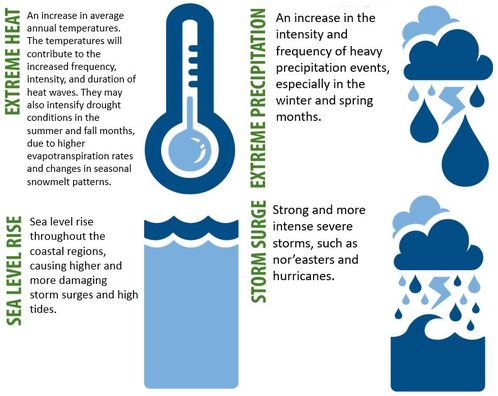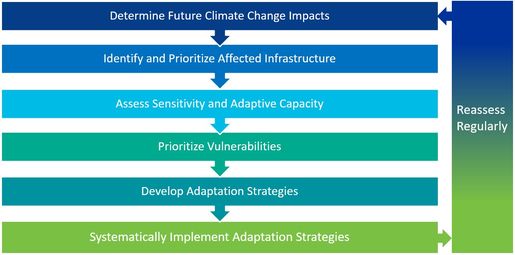Steps Towards Climate Change Resilience for Critical Infrastructure
By Lauren Miller, CC-P, Discipline Leader – Climate Resilience, CDM Smith
Global climate change has local impacts. The changing environment causes increasing financial and physical consequences, creating uncertainty for organizations managing critical infrastructure. It can be overwhelming to face this uncertainty, and to figure out how to prepare for it. Fortunately, most organizations can work within their existing framework to reduce the potential negative impacts of climate change on their infrastructure. They can work to become resilient.
The Context of Climate Change in Massachusetts:
Massachusetts is increasingly experiencing weather and climate events, which lead to critical infrastructure disruption because much of our infrastructure is not designed for current and projected climate conditions. The Northeast Climate Science Center at UMass Amherst’s Commonwealth of Massachusetts climate change projections through the end of the century predict:
- An increase in average annual temperatures with associated heat waves and drought conditions,
- An increase in the intensity and frequency of heavy precipitation events,
- Strong and more intense severe storms, and
- Sea level rise.

Figure 1. Climate Impacts in Massachusetts
The climate is changing, but we can plan for it. Using practical methodologies and tools, we can incorporate climate change into infrastructure planning and design. Understanding and quantifying the uncertainty in climate change projections and impacts is key. Then, system planning and design processes can account for uncertainty, managing risk and developing practical contingencies.
What is Resilience?
The Merriam-Webster dictionary defines resilience as:
- the capability of a strained body to recover its size and shape after deformation caused especially by compressive stress
- an ability to recover from or adjust easily to misfortune or change
In the context of climate change, resilience means anticipating and planning for climate change, to manage the risk. Building resilient means that when climate events occur, they do not cause significant or long-term disruption. The first step towards resilience is understanding the infrastructure’s vulnerability to climate change.
Understanding Vulnerability to Climate Change:
Climate change vulnerability assessments can be as broad or detailed as resources allow. An in-depth, quantitative vulnerability assessment leads to a higher level of confidence when evaluating climate impacts on assets and thereby supports more appropriate design conditions. However, even a broader, qualitative vulnerability assessment can help improve the resilience of critical infrastructure because the act of thinking through climate change consequences to your infrastructure at any scale is in and of itself an act of resilience. This might include a process such as that required through the Massachusetts Vulnerability Preparedness (MVP) Program, which uses a The Nature Conservancy’s Community Resilience Building model. The model allows communities to identify and document their vulnerabilities and strengths in the face of different climate change impacts.
In either case, the basics of any climate change vulnerability assessment are:
- Determining the future climate change impacts, including the magnitude and over what time horizon they may occur. Consider focusing on impacts that could more seriously affect the infrastructure.
- Identifying and prioritizing the affected infrastructure. Critical infrastructure includes assets or processes that are important to achieving an organization’s mission. Evaluating “criticality” in these terms lets you focus resources on what is more important.
- Assessing the assets’ sensitivity and adaptive capacity to the climate change impacts identified. “Sensitivity” is the degree to which the asset is affected by the exposure to the climate change impact and the known or predicted effects. “Adaptive capacity” is an asset’s ability to accommodate the impact and return to normalcy after a disruption. These evaluations can be completed quantitatively, by assigning numeric values, or qualitatively, based on the organization’s understanding of conditions.
- Prioritizing based on the vulnerability assessment outcomes. Assets that are more vulnerable to climate change take precedent. Outcomes may also be prioritized based on based on qualitative factors, like funding availability or community needs.
- Developing climate change adaptation – or resilience – strategies for prioritized vulnerabilities. Identify what the organization can do to reduce the vulnerability and improve the resilience of at-risk assets.
- Systematically implementing the identified adaptation strategies and reassessing regularly. This includes incorporating the future climate change parameters into design.

Figure 2. Process for Preparing for Climate Change
Establishing Climate Resilience Solutions:
An adaptation strategy reduces asset vulnerability to improve resilience. It provides a path for infrastructure to “adapt” to climate change impacts by retaining function during a weather or climate disaster event or resuming operations quickly after an event. The measures can strengthen existing infrastructure and weave resilience into new plans and designs. The adaptation strategy may also include future policy or operations and maintenance practices.
The key to implementing successful adaptation strategies lays in matching the magnitude and timeframe of expected future climate change conditions to the asset’s useful life. Using historic climate conditions will not lead to effective adaptation.
Consider the following questions when creating and implementing adaptation strategies:
- What are the main concerns regarding climate change at a facility or to key assets based on the outcomes of the vulnerability assessment? What is the magnitude of the consequences from climate change impacts the infrastructure might expect over the life of the equipment?
- What is the useful life of the given facility or key assets?
- What is the organization’s goal for implementing an adaption strategy? What is the organization’s risk appetite (i.e. does the organization wish to reduce risk to near zero or reduce only the most severe risks from climate change?)?
Answering these questions can help organizations meet the challenges of future climate change conditions over the asset lifetime. Organizations can make decisions about phasing certain aspects of the adaptation strategies over time through thoughtful capital improvement planning, therefore avoiding over-designing.
Climate Resilience as a Matter of Practice:
Organizations can empower themselves by taking the first steps towards resilience to climate change: evaluating the consequences and thinking through possible solutions in quantitative or qualitative ways. Engaging with this thought process will improve resilience and move towards stronger and more adaptable infrastructure, allowing life and business to carry on with minimal interruption and increased reliability in the face of climate change.
